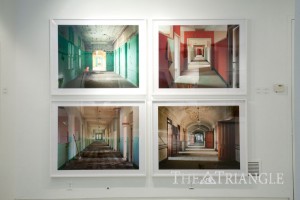Most people associate the term “mental asylum” with nightmarish, Hollywood-fueled images of cruelty and hopelessness. But Christopher Payne’s photographs, on display now through Oct. 29 at the Pearlstein Gallery, tell the true story of those old state hospitals, the crumbling remains of which still dot the quiet corners of the American landscape, standing as monuments to good intentions and the vanished hopes of institutionalized psychiatric care.

- Christopher Payne’s new photography exhibit is open now through Oct. 29 at the Pearlstein Gallery. Payne began collecting the photographs of old state hospitals in 2002. The free exhibit features 22 haunting photos.
The 22 haunting photos featured in the free exhibit, which is open to the public, represent a cross section of Payne’s latest book, “Asylum: Inside the closed world of state mental hospitals.”
Payne, a trained architect, originally set out producing the collection in 2002 to capture what was left of the institutions’ emblematic architecture. During a reception held at the gallery Oct. 5, Payne said that although his focus became increasingly personal over the years, his way into the project was through the buildings themselves. Likewise, our way into the collection is through a crisp black-and-white photo of Buffalo State Hospital. Its steep peaks and lancet windows make it appear more like a castle than any modern hospital.
According to Payne, this grandeur that was common among the majority of state hospitals built in the 19th and early 20th centuries was not only intended to establish an identity for the then-nascent practice of psychiatry, but was also believed to play a role in the actual rehabilitation of the patients. These buildings owe the splendor of their designs to the faith their designers had in the architecture and the notion of treating people with “respect and humanity,” Payne said.
But, “slowly,” he said, “the pendulum of care swung from the curative over to the custodial. And they became the human warehouses we know them as now.” Four photos, arranged two by two, show the apparently never-ending dormitory corridors of four separate hospitals. Though these hallways themselves are not endless, the illusion was often much closer to reality for patients on the inside, who would often develop the very symptoms the hospitals were trying to treat and never make it out.
According to Payne, the hospitals he photographed were remarkably tranquil once he got inside — he didn’t see any ghosts. Some of his photos do, however, answer our ghastly preconceptions. One photo of an in-hospital autopsy theater contains, lingering near the edge of the frame, an old chrome-plated bone saw, its black power cord still neatly wrapped up behind it, while another shows shelves filled with plain copper urns containing the unclaimed remains of patients. But these particularly grim photographs are contrasted by the many others that illustrate the sincerity and care at the heart of the original ideas behind the asylum.
Several illustrate the daily effort to reintroduce patients to outside society. In these photos, artifacts of pleasant day-to-day social life clash with austere walls and barred windows. As interesting as this contradiction is, equally interesting is the apparent immediacy with which the hospitals were finally abandoned due to various factors, including funding cuts and the advancement of psychiatric drugs. One photo shows the inside of an on-campus hair salon. The clock is frozen at 1:00 and pictures of designer cuts from the 80s, when the hospital closed, remain posted to an armoire — upon which sits a Barbicide jar that still contains some of the blue fluid.
As you continue around the exhibit, the photos capture the story of life inside the mental hospital with increasing personality. Suitcases of patients who never checked out remain stacked on attic shelves. Boxes overflowing with patient records lie in disarray. Plastic toothbrushes with nametags still attached hang neatly on hooks in a wooden cupboard. A half-used tube of toothpaste remains on the shelf.
One of the most moving photographs in the exhibit shows the many unadorned gray headstones that fill the large green cemetery of Connecticut Valley State Hospital. The gravestones in the foreground, which have fallen backwards over the growing roots of the ancient tree centered in the frame, reveal that the only identities these patients had in the end were the numbers they were assigned. However, even this sad scene conveys a sense of optimism for Payne, who said that although the hospitals themselves are left to decay, groundskeepers diligently maintain the cemeteries so that families can find the forgotten relatives who were buried there.
“All the cemeteries I photographed sort of conveyed some sense of hope, some sense of — I wouldn’t say a happy ending, but — you know, a conclusion.”
According to Gallery Director Dino Pelliccia, Painted Bride Quarterly co-editor Kathleen Volk Miller requested that the Pearlstein Gallery hold an exhibit featuring Payne’s work. Pelliccia said he eagerly agreed after seeing Payne’s portfolio and added that the exhibit, which he described as more historical and documentarian than others featured at the gallery, helps express the overall breadth of the capabilities of outstanding art.

